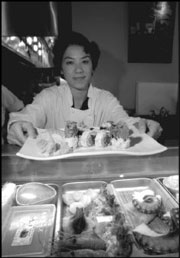Chinoise Cafe 610 Fifth S., 254-0413 11:30 a.m.-3 p.m., 4:30-9:30 p.m. Mon-Thurs.; 11:30 a.m.-3 p.m., 4:30-10:30 p.m. Fri; noon-10:30 p.m. Sat.; noon-9:30 p.m. Sun. AE, DC, MC, V / full bar
ASIAN CUISINES have become so mainstream in Seattle it’s almost impossible to remember when they were exotic. Thirty years ago, Chinese was about it. The few Japanese places in town were the Far Eastern edge of the mainstream comfort zone, what with all that raw fish; the whole city was not yet lousy with takeout teriyaki joints. There may have been one or two Vietnamese places, but they were tiny secrets; Indonesian, Thai, and Korean were virtually unheard of.
How times have changed. There’s nothing tiny or secret about restaurants like Monsoon or Wild Ginger, which have appropriated the best flavors of the Orient toward the creation of glorious pan-Asian menus. These places are glossy and designed, a far cry from the inimitable bleach-smelling-fluorescent-lit je ne sais quoi of Chinatown’s choicest hidey-holes, and they purvey their delicacies to global sophisticates who know what they’re eating and how it’s supposed to taste.
Chinatown is now the International District, of course, and nowhere is this mainstreaming more evident than at its southern edge. If you’ve been to the shiny new Uwajimaya, which looks like a Tokyo version of Larry’s Market, you’ve probably seen the adjoining Chinoise. This is part of a Seattle chain, with other Chinoises on Queen Anne and in the Madison Valley. It’s sleek and lovely inside, with teak-like appointments and butternut walls with sculptures upon them.
The menu is long, ranging the Orient in an enticing way. There’s wok food, like spicy ginger beef and green curry chicken; and Chinese faves, like pot stickers and mu shu pork and General Tso’s chicken; and Japanese faves, like tempura and udon bowls and all manner of sushi; and Korean food, like kalbi with kimchi; and Thai food, like phad Thai; and Vietnamese food, like lemon grass pork chops and herbed black cod; and unclassifiable “Asian” innovations, like honey walnut prawns and salmon skin salad. There’s literally something for everyone, whether you want to drop in solo and slosh down a beer and a snack, or enjoy a long, shared dining experience. This accommodating nature is foremost among Chinoise’s charms.
We roamed the menu with glee. Pot stickers ($6.95) were good (if tepid), both in their fried and steamed permutations. Vietnamese soft-shell crab ($6.95) was deep-fried and served with lettuce, cilantro, basil, and pickled veggies; it was fun to crackle into this beast, wrap pieces in the greens, and dip bites into the lime-chile-fish sauce. The coating on the crab was perhaps a bit heavy-handed, but the sauce was fine.
Yam fries ($4.95) were nothing but fun: sweet and greasy and delicious dipped into the accompanying cumin-lime sauce, which was like a feisty aﯬi. We also sampled some fresh but raggedly cut sushi. The sea eel (anago, $4.95), yellowtail (hamachi, $5.25), and salmon (sake, $4.20) were distinguished; the tuna (toro, $6.95) was disappointingly tough.
Our best starter featured terrific tuna, however. Five-spice tuna tataki ($8.95) featured slices of the seared fish coated in fire, served over alluringly oiled lettuces. A standout in flavor and texture, this one left us eager for what delights the entr饠list might hold.
Our anticipation was both fulfilled and frustrated. Where in most restaurants the chef’s most extravagant creativity is spent on starters, at Chinoise the greater verve appears to be in the mains.
THE BAD NEWS, alas, is that verve does not always a terrific dish make. The lush-sounding Vietnamese herbed black cod ($14.95) featured pan-fried cod in a bath of Roma tomatoes and roasted garlic, topped with an aromatic heap of saut饤 dill, cilantro, and basil. The fish erred on the greasy side, but the greater sin was a surfeit of incongruous elements—there was no chorus among the parts here.
An improbable Imperial Noodle Bowl ($9.95), in which grilled prawns and shoots of scallion were wrapped in bacon then served alongside fried Vietnamese egg rolls over rice noodles, was similarly weird. The parts were yummy enough, notwithstanding the overgrilled prawns, but just plain odd together.
Better, then, to aim for standards and expect them to be done in standard fashion. Grilled coconut chicken ($9.95), featuring dark meat marinated in lemon-grass-curry- coconut sauce, featured all the fragrant layers of flavor one expects to find in this dish, along with rice noodle salad and a thick peanut sauce.
Kalbi-marinated short ribs served with rice, mild kimchi, and a bowl of rich miso soup ($14.95) were just as fine—exactly what you’d expect and quite satisfying. Same for the chicken lo mein ($8.25), which featured nice crunchy carrots, broccoli, and snow peas amidst the noodles, and not a single challenge. Same for the spicy Thai cashew shrimp ($11.95): a plentiful bowl of shrimp—this time flawlessly cooked—with green beans and cashews stir-fried in a sassy red curry.
If the above descriptions ring as faint praise, let me stress that the dishes were faultlessly tasty and so satisfying we didn’t once order dessert (sorry). They were just, well, mainstream—the inevitable and not entirely unhappy consequence of the popularization of deservedly popular cuisines.








